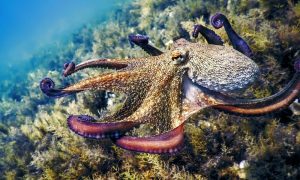One day in late June, wildlife photographer Brent Cizek set out on the choppy waters of Minnesota’s Lake Bemidji in his small plastic boat. Equipped with just one lens and one camera, Cizek planned to only take a few snapshots – until he stumbled upon a common merganser hen swimming in the lake with an estimated 50 ducklings in tow.
Only one of Cizek’s images of the large brood turned out, prompting him to return to the lake, which is located about 150 miles northwest of Duluth. During one of his return trips in July, the amateur photographer counted not 50, but 76 ducklings! The hen in charge was appropriately nicknamed Mama Merganser, and Cizek captured some amazing snapshots of the freshwater duck family, which have since gone viral.
The ducklings don’t all belong to Mama Merganser, however. Common merganser hens lay up to a dozen eggs at a time and often dispense them into the nests of other birds, which increases the chances of survival by spreading the offspring. However, according to Richard O. Prum, an ornithologist at Yale University, it would be impossible for one hen to incubate 76 – or even 50 – eggs.
So, what’s really going on in this photo? Common mergansers are one of several species of birds that use a “daycare” system, known as a crèche, to raise their offspring. An older, matriarchal female takes charge of the ducklings when the adult hens leave to molt their feathers. David Rave, a local wildlife manager for the Minnesota Department of Natural Resources, describes the role of experienced hens like Mama Merganser as “kind of like a great-grandmother.”
Mr. Rave is used to seeing crèches of “up to 35 and 50,” but acknowledges that a crèche of 70 ducklings is exceptionally large.
During his return trips to Lake Bemidji, Mr. Cizek has witnessed the other adult ducks, but states that the ducklings continue to follow Mama Merganser, who has earned the nickname ‘Mom of the Year.’






